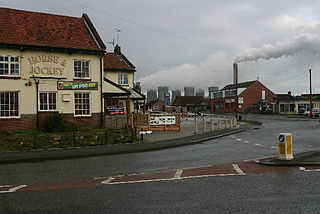Related Research Articles

The River Aire is a major river in Yorkshire, England, 92 miles (148 km) in length. Part of the river below Leeds is canalised, and is known as the Aire and Calder Navigation.

Airedale is a geographic area in Yorkshire, England, corresponding to the river valley or dale of the River Aire.

Drax power station is a large biomass power station in Drax, North Yorkshire, England, capable of co-firing petroleum coke. It has a 2.6 GW capacity for biomass and 1.29 GW capacity for coal. Its name comes from the nearby village of Drax. It is situated on the River Ouse between Selby and Goole. Its generating capacity of 3,906 megawatts (MW) is the highest of any power station in the United Kingdom, providing about 6% of the United Kingdom's electricity supply.

Knottingley is a town in the City of Wakefield in West Yorkshire, England on the River Aire and the old A1 road before it was bypassed as the A1(M). Historically part of the West Riding of Yorkshire, it has a population of 13,503, increasing to 13,710 for the City of Wakefield ward at the 2011 Census. It makes up the majority of the Knottingley ward represented on Wakefield Council.

Fiddlers Ferry Power Station is a decommissioned coal fired power station located in Warrington, Cheshire, England. Opened in 1971, the station had a generating capacity of 1,989 megawatts and took water from the River Mersey. After privatisation in 1990, the station was operated by various companies, and from 2004 to 2022 by SSE Thermal. The power station closed on 31 March 2020. The site was acquired by Peel NRE in July 2022.

Eggborough is a village and civil parish, in the Selby District of North Yorkshire, England, close to the county borders with South Yorkshire, West Yorkshire and the East Riding, effectively making it the meeting point for all sides of Yorkshire.

Longannet power station was a large coal-fired power station in Fife, and the last coal-fired power station in Scotland. It was capable of co-firing biomass, natural gas and sludge. The station stood on the north bank of the Firth of Forth, near Kincardine on Forth.

The Ferrybridge power stations were a series of three coal-fired power stations on the River Aire near Ferrybridge in West Yorkshire, England, in operation from 1927 to 2016 on a site next to the junction of the M62 and A1(M) motorways.

Ferrybridge is a village in West Yorkshire, England. Ferrybridge lies at a historically important crossing of the River Aire which borders the North Yorkshire village of Brotherton. It is linked to other communities by the A1, which follows the route of the Great North Road. The village falls within the Knottingley ward of Wakefield City Council.

Didcot power station is an active natural gas power plant that supplies the National Grid. A combined coal and oil power plant, Didcot A, was the first station on the site which opened in 1970 and was demolished between 2014 and 2020. The power station is situated in Sutton Courtenay, near Didcot in Oxfordshire, England. Additionally Didcot OCGT is a gas-oil power plant, originally part of Didcot A and now independent that continues to provide emergency backup power for the National Grid.

Drax Group PLC is a power generation business. The principal downstream enterprises are based in the UK and include Drax Power Limited, which runs the biomass and coal fuelled Drax power station, near Selby in North Yorkshire. The Group also runs an international biomass supply chain business. The company is listed on the London Stock Exchange and is a constituent of the FTSE 250 Index.

Eggborough power station was a coal-fired power station in North Yorkshire, England, which was capable of co-firing biomass. It was situated on the River Aire, between the towns of Knottingley and Snaith, deriving its name from the nearby village of Eggborough. The station had a generating capacity of 1,960 megawatts, enough electricity to power 2 million homes, equivalent to the area of Leeds and Sheffield.

Norton railway station was a railway station to serve Norton, South Yorkshire, England. It was built by the Wakefield, Pontefract and Goole Railway company on their line between Doncaster and Knottingley. The line and its stations were absorbed into the Lancashire and Yorkshire Railway in 1847 when that company changed its name from the Manchester and Leeds Railway.
Blackburn Meadows power station is a biomass power station situated at Blackburn Meadows on the River Don, between Sheffield and Rotherham in South Yorkshire, England. Operated by E.ON UK, it was opened in 2014 and has an operating capacity of 30 megawatts.

High Marnham Power Station was a coal fuelled power station in Nottinghamshire, to the west of the River Trent, approximately 0.5 miles (0.8 km) north of the village of Marnham. Construction site clearance began in November 1955, No. 1 Unit power generation commenced in October 1959, and the station became fully operational in June 1962. The plant operated until 2003 when it was decommissioned, though the cooling towers weren't demolished until 2012.
Bold Power Station refers to a series of two coal-fired power stations in Bold near St Helens, Merseyside, North West England. They were closed, decommissioned and demolished between 1981 and 1992, and a housing estate now occupies the site.

Kirkstall power station was a coal-fired unit opened in 1930, serving the city of Leeds, West Yorkshire, England.

Knottingley TMD was a traction maintenance depot located in Knottingley, West Yorkshire, England. The depot was situated on the Pontefract Line and was near Knottingley station. It opened in 1967 to maintain the locomotives and hopper wagons for a planned 75 Merry-go-round trains a day, expected to use the Wakefield and Goole line.

Megawatt Valley is a term applied to a geographic location which houses a large number of electricity generating stations. Historically in the United Kingdom this applied to the coal-fired power stations of the lower Trent Valley. In the mid-1980s, the valley's 13 facilities generated up to a quarter of the power demand for England and Wales. A shift to gas-fired power stations saw many of the Megawatt Valley facilities close down. The term was then associated with an area of Yorkshire centred on the River Aire that was home to Ferrybridge C, Eggborough and Drax power stations. Of these facilities only Drax remains in operation. In the United States the term has been applied to an area of West Virginia, home to five power stations.
References
- 1 2 Pickering, Kevin T.; Owen, Lewis A. (1997). An introduction to global environmental issues (2 ed.). Routledge. p. 162. ISBN 0-415-14098-6.
- ↑ House of Commons North West Regional Committee. The Stationery Office. 2010. Fig.1 "Large Point Sources of Carbon Emissions in the Region by size and sector, 2006", Ev.2; "Environment Agency", Ev. 9. ISBN 978-0-215-55352-2.
- 1 2 Haywood, Russ (2009). Railways, urban development and town planning in Britain: 1948–2008. Ashgate Publishing, Ltd. pp.128–129; Appendix 10, "Rail freight services and power stations: 1970–2005", p.359. ISBN 978-0-7546-7392-7.
- ↑ "2.6 Underground mining". Energy resources: Coal (Report). The Open University . Retrieved 1 April 2012.
- ↑ "Electricity Supplies". Hansard: House of Commons. 46. cc770-1. 25 July 1983.
How will Ferrybridge, Eggborough, Drax and other power stations be supplied with coal if Selby cannot supply them?
- ↑ "Freight: Route Utilisation Strategy" (PDF). Network Rail. March 2007. pp.3; 5; 37; 90; 101; 125, "Figure B1: Key import coal routes and coal loading points". Archived from the original (PDF) on 2 March 2012. Retrieved 1 April 2012.
- ↑ "Power station begins closure consultation". BBC. September 2015. Retrieved 3 September 2015.
- ↑ "Ferrybridge C coal-fired power station closes after 50 years". BBC News. BBC. 23 March 2016. Retrieved 23 March 2016.
- ↑ "Reprieve for threatened Eggborough Power Station". BBC News. Retrieved 11 March 2016.
- ↑ "Eggborough power station to close with loss of 170 jobs". BBC News. 2 February 2018. Retrieved 22 August 2021.
- ↑ "Tower demolished at Ferrybridge Power Station". BBC News. Retrieved 12 March 2022.
- ↑ "Ferrybridge Power Station: Live updates as four more cooling towers are demolished". Wakefield Express . 13 October 2019. Archived from the original on 13 October 2019.
- ↑ Hammond, Grace. "Onlookers gather to watch as huge cooling towers are demolished at landmark Yorkshire power station". The Yorkshire Post . Retrieved 12 March 2022.
- ↑ Withers, Laura (22 August 2021). "Live Ferrybridge Power Station demolition as M62 and surrounding roads closed". Leeds Live. Retrieved 12 March 2022.
- ↑ Hutchinson, Andrew (10 October 2021). "Eggborough power station demolition: Remaining cooling towers come crashing down". The Yorkshire Post. Retrieved 10 October 2021.
- ↑ Newton, Grace (8 March 2022). "Watch moment 12,000-ton coal bunker at Eggborough power station is demolished with explosives". The Yorkshire Post. Retrieved 8 March 2022.
- ↑ "Final Ferrybridge power station cooling towers demolished". BBC News. 17 March 2022. Retrieved 21 March 2022.
- ↑ Pritchard, Jonathan (2 June 2022). "Eggborough power station demolition: Watch latest demolition carried out at iconic site". The Yorkshire Post. Retrieved 3 June 2022.
- ↑ "Regeneration continues at Eggborough Power Station site". Selby Times . 1 June 2022. Retrieved 3 June 2022.
- ↑ "Watch as final part of Eggborough power station is demolished with explosives | ITV News". ITV News. 24 July 2022. Retrieved 24 July 2022.